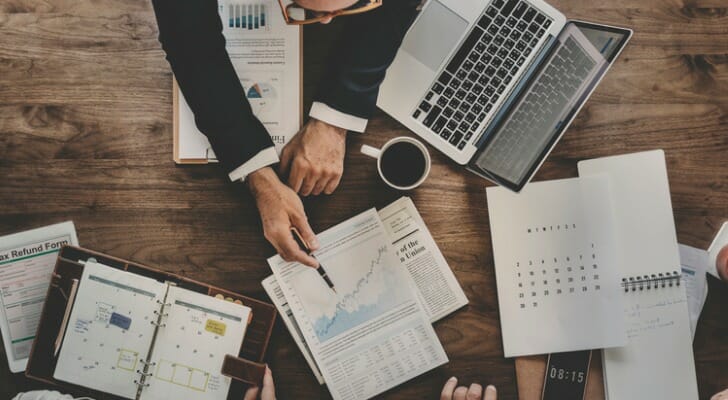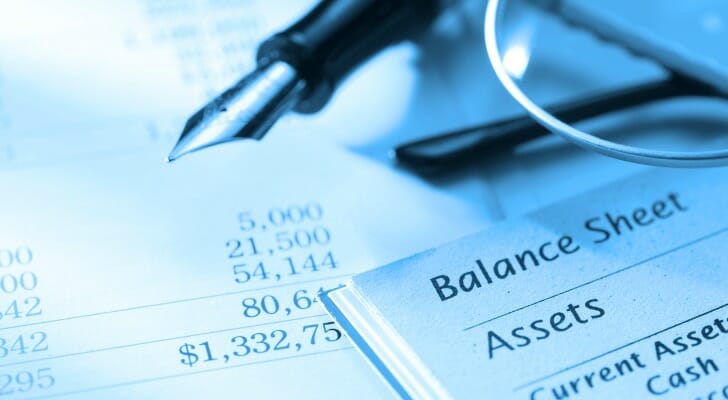A balance sheet is a financial document that a company releases to show its assets, liabilities and overall shareholder equity. Balance sheets are useful tools for potential investors in a company, as they show the general financial status of a company. Be warned, though, that these only show the state of a company right now. To see a company’s trajectory, you’ll need to look at balance sheets over a time period of months or years.
Have questions about building an investment portfolio? Speak with a financial advisor today.
What Information Does a Balance Sheet Include?
A balance sheet is a financial statement that shows you three things about a company:
- Assets: How much the company owns
- Liabilities: How much the company owes
- Shareholder equity: What’s left when you subtract liabilities from assets
A balance sheet only shows you a company’s financial status at one point in time. If you want to know how a company’s assets and liabilities have changed over time, you will need to have historical balance sheets to compare.
What Types of Assets Does a Balance Sheet Show?
Let’s explore some of the current assets you might see on a balance sheet:
Cash and Equivalents
These are the most liquid assets and appear first in the list on the balance sheet. Cash equivalents are assets that the company can liquidate on short notice – less than one year. Maybe that’s a U.S. Treasury bill, certificate of deposit (CD) or similar short-term investment. If a company has equivalents, it will generally name them in the footnotes of the balance sheet.
Accounts Receivable
Accounts receivable includes money that the company has made from sales that it has yet to collect. The sales revenue could still be on credit or perhaps it’s a bad debt expense (money that the company cannot collect from a customer for some reason). When the company does collect this revenue, the value of accounts receivable will decrease and the amount of cash will increase by an equal amount.
Inventory
Inventory includes all goods that the company has and can sell. This also includes goods that are still works in progress and any raw materials that the company has for producing goods.
Balance Sheet Long-Term Assets
Long-term (“fixed”) assets are those assets that cannot be easily liquidated or sold. They often represent long-term capital investments that a company has made in its future – everything from factories to patents to investments in other companies.
Long-Term Investments
Unlike equivalents (current assets), these are investments a company has that it cannot liquidate within the next year.
Property, Plant, and Equipment
This category includes a company’s tangible assets. Not all balance sheets will use this exact terminology and so you may see another title that covers a company’s property and equipment. Assets in this category – with the exception of land – will generally depreciate over time. You will also see a line that lists the depreciation of these assets.
Intangible Assets
You can generally break intangible assets into two types: intellectual property (also called identifiable intangible assets) and goodwill (also known as an unidentifiable intangible asset). Intellectual property includes things like patents, licenses, copyrights, trademarks and customer lists.
Goodwill is an asset that comes when one company purchases another. In particular, goodwill appears when one company purchases another at a price that’s higher than the value of all that company’s tangible assets. Common reasons the purchase price might be higher than fair value is because a company already has a recognizable brand name or a strong customer base.
Let’s say, for instance, that a large company acquires a retail company; while the retailer has only $7 billion in tangible assets, it pays $10 billion because the retailer has a great brand name. The $3 billion difference goes onto the large company’s balance sheet as goodwill.
Using a Balance Sheet to Analyze a Company’s Assets

An asset is anything of value the company has. This includes cash, investments and tangible objects. Companies divide their assets into two categories: current assets and long-term assets.
Current assets are things that the company can convert into cash within one year. This includes cash, investments like stocks or bonds, prepaid expenses and physical inventory. A balance sheet will break down the value of each type of current asset.
Long-term assets are tangible assets that the company uses over the long term. Examples are property, buildings, furniture, vehicles, equipment and machinery. Note that some companies refer to these as “noncurrent assets” or “fixed assets.”
Analyzing Liabilities on a Balance Sheet
Liabilities are any money that a business owes. They cover bills for supplies, rent, utilities, company salaries, loans or deferred taxes. Just like assets, there are two types of liabilities: current liabilities, which a company owes within the next year, and long-term liabilities, which the company must pay anytime beyond one year from now.
Current Liabilities on a Balance Sheet
Current liabilities include any money that the company owes to other parties in the short term.
Accounts Payable
Accounts payable covers what a company owes to its suppliers. It also includes services the company purchased using credit. As the company pays off these liabilities, its cash (current assets) will decrease by an equal amount.
Current Debt and Notes Payable
This includes any promissory notes that a company has issued. A promissory note is simply an agreement by the company to pay a certain amount of money by a certain date. A common scenario that results in a note is when a company buys expensive equipment but does not pay the entire price immediately.
If a company has debt or accounts payable, it will also have to pay interest on that debt. The result is another line on the balance sheet for “interest payable.”
Again, this is a short-term liability so the company owes the price within one year. You may also see a section on a balance sheet for long-term debt and notes payable.
Current Portion of Long-Term Debt
Long-term debt is primarily included in the long-term liabilities section. However, any money that a company owes on that debt within the next year will be included here. For example, say that a company takes out a loan that’s 10 years long. The company doesn’t have to pay the full loan in the upcoming year, but it does have to pay a certain amount. That amount falls into this category. Not all companies will list this liability and some will lump it with the current debt that we talked about in the previous section.
Long-Term Liabilities on a Balance Sheet
If a company borrows money but doesn’t have to pay it back in the short term, it’s accounted for here.
Bonds Payable
Bonds payable include any bond that the company has issued. The value here is the amortized amount of the bond. Amortization is the process of taking an expense and expanding its cost over the life of the expense.
Other Long-Term Debt and Liabilities
Bonds may be just one part of the long-term liability picture. Any other debt and liability that doesn’t have to be paid in the next year should be included. (If the balance sheet listed the current portion of this debt in the “Current Liabilities” section, it is excluded from this section.) Other long-term liabilities will include any other loans or long-term debt the company may have taken on. It may also include an estimate of what the company will have to pay to employees with pensions, and any other types of deferred compensation.
A company will have a schedule that outlines its outstanding debt, including interest expenses, and how much the company must pay per period.
Analyzing Shareholder Equity on a Balance Sheet

Shareholders’ equity is the money that goes to a company’s owners or shareholders. You can calculate it simply by subtracting liabilities from total assets. That means shareholders’ equity is also the company’s net income, net worth and overall value. This is an important number to investors because you can see the company’s worth. More equity also means more money for shareholders.
If a company has negative equity, that means the value of its assets is not enough to cover all its liabilities. This is a common situation with new companies and startups. However, a company with a negative shareholders’ equity is riskier to invest in than a company with a positive equity value.
Retained Earnings
Shareholders’ equity tells you how much a company has left after covering its liabilities. If it wanted to, the company could then pay out all of that money to its shareholders. This happens in the form of dividends. However, it’s more likely that the company reinvests the money into the company. The money that the company keeps is its retained earnings. Even if a company does pay dividends to shareholders, it may still retain some money.
Share Capital
This is the value of what investors have invested in the company. For example, let’s say you start a company and someone invests $100,000 to help you start your company. On a balance sheet, you would count that $100,000 with your cash assets and you would also count it as part of your share capital.
Stocks
You may also see lines in the shareholders’ equity section for stock. Common stock is what most people get when they buy stock through the stock market. Preferred stock entitles the shareholder to a greater claim on the company’s assets and earnings. If a company were to close and liquidate all of its assets, the value would go first to preferred stock holders and then to common stock holders. You may also see treasury stock on a balance sheet. Treasury stock is stock that company wither never issued or repurchased.
What Are the Benefits of Reviewing at a Balance Sheet?
Balance sheets are useful to investors because they show how much a company is actually worth. Some of the information on a balance sheet is useful simply in and of itself. For example, you can check things like the value of the company’s assets and how much debt a company has. You can even dig a little deeper to see what percentage of a company’s assets are tangible objects like machines and vehicles.
Investors can also use the numbers from a balance sheet in some useful financial equations that help analyze the value of a company. Here are a few.
Working capital = current assets – current liabilities
This is the capital a company has to use in its day-to-day trading operations.
Debt-to-equity ratio = total liabilities ÷ shareholders’ equity
This tells you how much of a company’s financing comes from investors versus creditors. Investors generally consider companies with higher ratios (that is, with more financing from debt) as riskier investments. Unlike equity, a company needs to pay back all of the debt that it owes. So the more debt a company has, the more it has to make just to pay back that debt. Company’s with lower debt to equity ratios are seen as more stable. You may also see the term debt/equity ratio or the abbreviation D/E ratio.
Quick ratio = (cash and equivalents + marketable securities + accounts receivable) ÷ current liabilities
Also known as the acid-test or the liquidity ratio, this is a measurement of a company’s ability to cover its short-term liabilities. A ratio greater than one indicates that the company has enough in cash and cash equivalents to pay its obligations and cover its operations.
Bottom Line

A balance sheet is a document that businesses can use to summarize their company’s financials, and which investors can then use to determine the value of a company. It details a company’s assets and liabilities, along with the value of its stock.
The information on a balance sheet is independently useful too. You can also use them in conjunction with other financial documents, like an income statement or a cash flow statement. Combining the insights of all three of these documents can help you determine whether investing in a company is the right choice for you. Financial advisors often have a proficiency in evaluating balance sheets if you’d like to include this kind of fundamental analysis in your investing plan.
Investing Tips
- Consider working with a financial advisor if you’d like help managing your investments. Finding a financial advisor doesn’t have to be hard. SmartAsset’s free tool matches you with up to three vetted financial advisors who serve your area, and you can interview your advisor matches at no cost to decide which one is right for you. If you’re ready to find an advisor who can help you achieve your financial goals, get started now.
- One of the most important things to figure out when you begin investing is your personal asset allocation. SmartAsset’s asset allocation calculator can be used to determine just what your portfolio’s asset allocation should look like.
Photo credit: ©iStock.com/DNY59, ©iStock.com/milanvirijevic, ©iStock.com/Rawpixel, ©iStock.com/Kritchanut
